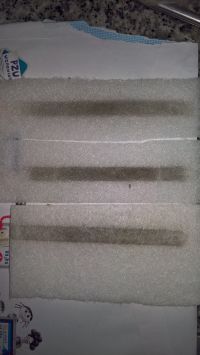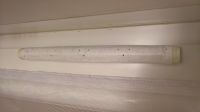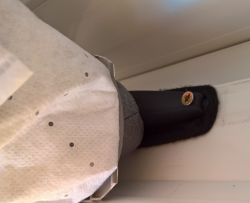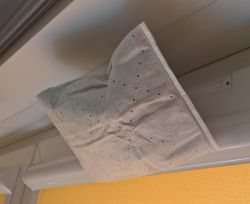Hello!
I live in a block of flats, in the city, in addition on the ground floor. I have long recognized the fight against dust as a loss - no matter how much I get when cleaning, soon after all all black elements are gray and cats from dust fly across the floor like dry bushes in wild west films.
Recently, however, I am thinking a lot about the famous smog because it is loud everywhere, and I began to wonder if I could do something to improve the quality of air in the house and by the way cover the problem of dust. No one at home has any allergies etc., but with the increase in awareness of what we are breathing, the internal need to respond in any way increases.
I began to think about using window ventilators as filters, which probably get 99% of pollution into my apartment. Ventilation generally works great - it pulls in the kitchen and bathroom, and all fresh air ventilates beautifully "fresh" air.
Now yes - I considered:
1. Installation of the filter fleece used in vacuum cleaners inserted under the vent, yesterday, even with the inflow of ventilation in the middle of the night, I installed two such "devices". I'll take it off in a few days and check what has stopped on them. The solution has one minus - it significantly limits the air flow and it seems to me that I would either have to use the nonwoven fabric already in the ventilator from the inside or mill more holes in the window frame (currently only 1/3 of the ventilator cross-section is used in the factory, I suspect that according to with a project because if the whole air flowed, I probably wouldn't be able to keep the apartment warm). This solution also does not solve the topic of suspended particulates.
2. Installation of Ventboo filters http://www.ventboo.pl/. They don't convince me something, I don't know why, theoretically the producer gives about 90-95% of dust filtering and there is nothing about smog, etc. Generally, it looks a bit like a marketing gimmick - a thin film, which because it stops something , after a while it turns black and the user is excited that "it filters so well".
3. The same as above, only with the use of the pollen filter used in cars. Theoretically, this should stop everything, including bacteria etc. in the activated carbon version. By the way, even the carbon version has a white outer layer and it would be known after what time to consider replacing. In addition, the solution would not be expensive - you only need the largest filter, just remove the frame and cut into strips.
The MANN filter producer gives very promising info: https://www.mann-hummel.com/en/corp/news/news...83f1bf086b4fe21f4ec8cb&tx_ttnews[tt_news]=682
4. Also like the above solutions, but using a filter through which air enters the engine. Certainly a very cheap solution and it seems quite effective, although it can give a lot of resistance.
5. And the same thing again, but with the use of a filtration nonwoven soaked in activated carbon, used e.g. in hoods or recuperators (e.g. https://pureventfilters.eu/filtry-plaskie-weglowe/535-filtr-plaski-weglowy-g4- 396x245.html)
6. I like this idea the most, although the implementation can be a little complicated. I was thinking about using a hepa filter (e.g. h13 to capture over 99% of impurities) that is used in vacuum cleaners. The only problem is that it will stand out a lot and you would have to make a somewhat aesthetic "can" in which you could place such a filter. The advantage is the low price - a dozen zlotys, and a large cross-section of air flow.
If any of you have similar thoughts, feel free to write. Or maybe you already have some solutions of your own, or there is something ready on the market that I haven't reached?
Best wishes
Peter
I live in a block of flats, in the city, in addition on the ground floor. I have long recognized the fight against dust as a loss - no matter how much I get when cleaning, soon after all all black elements are gray and cats from dust fly across the floor like dry bushes in wild west films.
Recently, however, I am thinking a lot about the famous smog because it is loud everywhere, and I began to wonder if I could do something to improve the quality of air in the house and by the way cover the problem of dust. No one at home has any allergies etc., but with the increase in awareness of what we are breathing, the internal need to respond in any way increases.
I began to think about using window ventilators as filters, which probably get 99% of pollution into my apartment. Ventilation generally works great - it pulls in the kitchen and bathroom, and all fresh air ventilates beautifully "fresh" air.
Now yes - I considered:
1. Installation of the filter fleece used in vacuum cleaners inserted under the vent, yesterday, even with the inflow of ventilation in the middle of the night, I installed two such "devices". I'll take it off in a few days and check what has stopped on them. The solution has one minus - it significantly limits the air flow and it seems to me that I would either have to use the nonwoven fabric already in the ventilator from the inside or mill more holes in the window frame (currently only 1/3 of the ventilator cross-section is used in the factory, I suspect that according to with a project because if the whole air flowed, I probably wouldn't be able to keep the apartment warm). This solution also does not solve the topic of suspended particulates.
2. Installation of Ventboo filters http://www.ventboo.pl/. They don't convince me something, I don't know why, theoretically the producer gives about 90-95% of dust filtering and there is nothing about smog, etc. Generally, it looks a bit like a marketing gimmick - a thin film, which because it stops something , after a while it turns black and the user is excited that "it filters so well".
3. The same as above, only with the use of the pollen filter used in cars. Theoretically, this should stop everything, including bacteria etc. in the activated carbon version. By the way, even the carbon version has a white outer layer and it would be known after what time to consider replacing. In addition, the solution would not be expensive - you only need the largest filter, just remove the frame and cut into strips.
The MANN filter producer gives very promising info: https://www.mann-hummel.com/en/corp/news/news...83f1bf086b4fe21f4ec8cb&tx_ttnews[tt_news]=682
4. Also like the above solutions, but using a filter through which air enters the engine. Certainly a very cheap solution and it seems quite effective, although it can give a lot of resistance.
5. And the same thing again, but with the use of a filtration nonwoven soaked in activated carbon, used e.g. in hoods or recuperators (e.g. https://pureventfilters.eu/filtry-plaskie-weglowe/535-filtr-plaski-weglowy-g4- 396x245.html)
6. I like this idea the most, although the implementation can be a little complicated. I was thinking about using a hepa filter (e.g. h13 to capture over 99% of impurities) that is used in vacuum cleaners. The only problem is that it will stand out a lot and you would have to make a somewhat aesthetic "can" in which you could place such a filter. The advantage is the low price - a dozen zlotys, and a large cross-section of air flow.
If any of you have similar thoughts, feel free to write. Or maybe you already have some solutions of your own, or there is something ready on the market that I haven't reached?
Best wishes
Peter







